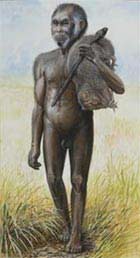A recent study has debunked the hypothesis that the tiny human fossil found in Indonesia in 2004 was a new species. After examining the phenomenon of dwarfism in various animal species, researchers suggest that Homo floresiensis was merely a modern human living under harsh conditions.
 |
|
The Homo floresiensis may have looked like this. (Photo: BBC) |
The remains of a small woman were discovered in a cave on Flores, Indonesia. Named H. floresiensis after its discoverers, she quickly became known as the “Hobbit.” During the initial announcement in 2004, some anthropologists debated whether this represented a new species. They noted that the skeleton exhibited characteristics of modern humans, including a small head—a phenomenon commonly observed in isolated human populations, often accompanied by reduced brain function.
Peter Brown and Mike Morwood from the University of New England, Australia, hypothesized that Homo floresiensis, with a brain size of 380 cm³, was a product of dwarfism or insular dwarfism, a phenomenon previously recognized. This phenomenon refers to species that, when isolated under the pressure of limited food resources, evolve to become smaller or larger than their ancestral forms. In the case of Homo floresiensis, researchers believe that this 1-meter tall human descended from Homo erectus (an extinct ancient human species that settled on Flores about 800,000 years ago) in a smaller direction.
However, with a brain size of 380 cm³, some argue that the Hobbit’s cranial capacity (equivalent to that of a chimpanzee) is too small to be considered a dwarfed Homo erectus. Now, further research supports this viewpoint.
Ann MacLarnon from Roehampton University in the UK, who has studied dwarfism in a range of animals from dogs to elephants, provides a new perspective: “If dwarfed, the process of shrinking brain size would be much slower than that of body size.”
“Brain size is key to identifying a species,” she stated. For instance, there is virtually no difference in brain size between the smallest modern humans (the Bambuti, who are 1.4 meters tall in Congo) and the tallest (the Maasai, who reach 2 meters in East Africa).
Her team calculated that a dwarfed Homo erectus with a brain capacity of 400 cm³ would weigh only about 2 kilograms. “This figure is just 1/10 of what the weight of a typical Flores individual should be.” The only explanation for this difference is the phenomenon of skull reduction. Since this condition is associated with genetics, it would be inherited through families.
“The most reasonable possibility here is that they were dwarfs—modern Homo sapiens with small heads. They developed mentally to a high degree,” stated Robert Martin, the lead researcher.
“Although we only have one skull, the other bones we found demonstrate that she was a normal member of an isolated dwarf population,” Morwood added.
T. An


















































